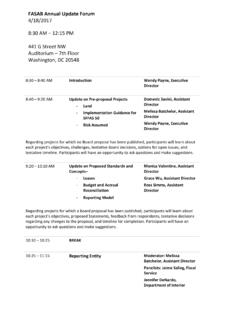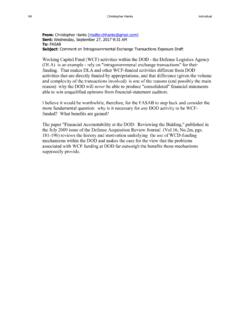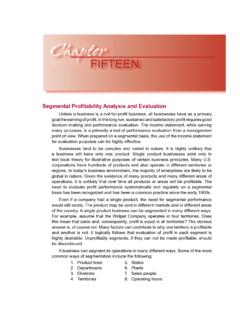Transcription of Evaluating and Improving Costing in Organizations
1 Page 1 of 29 July 2009 Professional Accountants in Business Committee International Good Practice Guidance Evaluating and Improving Costing in Organizations 2 The Professional Accountants in Business (PAIB) Committee of the International Federation of Accountants (IFAC) approved this International Good Practice Guidance, Evaluating and Improving Costing in Organizations , for publication in July 2009. The PAIB Committee welcomes your feedback on this document. Comments should be addressed to: Professional Accountants in Business Committee International Federation of Accountants 545 Fifth Avenue, 14th Floor New York, New York 10017 USA Email comments should be sent to.
2 The mission of the International Federation of Accountants (IFAC) is to serve the public interest, strengthen the worldwide accountancy profession and contribute to the development of strong international economies by establishing and promoting adherence to high-quality professional standards, furthering the international convergence of such standards and speaking out on public interest issues where the profession s expertise is most relevant. This publication was prepared by IFAC s PAIB Committee which serves IFAC member bodies and the more than one million professional accountants worldwide who work in commerce, industry, the public sector, education, and the not-for-profit sector.
3 Its aim is to enhance the role of professional accountants in business by encouraging and facilitating the global development and exchange of knowledge and best practices. This publication may be downloaded free-of-charge from the IFAC website at The approved text is published in the English language. Copyright July 2009 by the International Federation of Accountants (IFAC). All rights reserved. Permission is granted to make copies of this work provided that such copies are for use in academic classrooms or for personal use and are not sold or disseminated and provided that each copy bears the following credit line: Copyright July 2009 by the International Federation of Accountants (IFAC).
4 All rights reserved. Used with permission of IFAC. Contact for permission to reproduce, store or transmit this document. Otherwise, written permission from IFAC is required to reproduce, store or transmit, or to make other similar uses of, this document, except as permitted by law. Contact ISBN: 978-1-60815-037-3 3 Preface to IFAC's International Good Practice Guidance A separate document, entitled Preface to IFAC s International Good Practice Guidance, sets out the scope, purpose, and due process of the PAIB Committee s International Good Practice Guidance series to which this guidance paper belongs.
5 It can be downloaded free-of-charge from the PAIB section of the IFAC online bookstore at 4 IFAC PAIB COMMITTEE INTERNATIONAL GOOD PRACTICE GUIDANCE Evaluating AND Improving Costing IN Organizations CONTENTS Page Evaluating and Improving Costing in Organizations .. 5 1. Why the Topic is Important .. 5 The Role of the Professional Accountant in Business .. 8 2. Key Principles of Evaluating and Improving Costing in Organizations .. 10 3. Practical Guidance on Implementing the Principles .. 12 Appendix A: Resources .. 29 Appendix B: Definitions .. 31 Appendix C: Specific Arrangements in Jurisdictions and Sectors.
6 35 Appendix D: Cost and Decision Support Methods and Tools .. 37 Appendix E: Examples of the Challenges that Result from Managerial Information Being Based on Financial Accounting Data .. 40 IFAC PAIB COMMITTEE INTERNATIONAL GOOD PRACTICE GUIDANCE 5 Evaluating and Improving Costing in Organizations 1. Why the Topic is Important The creation, operation, alteration, and cessation of every action and function in an organization whether within the private, public, or voluntary sector all consume economic resources. Measuring, accumulating, and assigning those resources to the organization s various processes and outputs allows the structure and operation of the organization to be explained, understood, and improved.
7 Costing , the accounting term that embraces these processes and expresses them using money as a common language, lies at the heart of managerial accountancy and, exercised intelligently, is among the most powerful disciplines available to professional accountants in business (PAIB). Costing contributes to an understanding of how profits and value are created, and how efficiently and effectively operational processes transform input into output. It can be applied to resource, process, product/service, customer, and channel-related information covering the organization and its value chain.
8 Costing information can be used to provide feedback on past performance, and to motivate and change future performance. Costing is thus an essential tool in creating shareholder and stakeholder value. Given its importance and breadth of scope, it is unsurprising that many different Costing methods exist, both in the literature and in practice. This can create confusion and uncertainty for managers, and PAIBs need a sufficient understanding of sound Costing principles to be able to select and apply useful approaches. The basic building blocks of Costing are operational measurements of consumed resources (resources include people, space, equipment, and consumables, these being the drivers of cost and levers of change).
9 Such measurements enable managers to draw conclusions and make judgments about why (a) the organization s results turned out as they did (performance evaluation), (b) what this means for the future (planning), and (c) the probable results of available courses of action ( analysis of alternatives) all of which comprise essential information for effective decision making. The principles in this International Good Practice Guidance (IGPG) support the application of judgment in providing good decision support. In turn, this calls for the professional accountant in business to clearly understand why cost information is to be used.
10 For example, Improving existing operational performance needs different treatment from that required to develop future strategy, although an ability to effectively relate managerial actions to their effects will be common to both objectives. The inclusion of measurement of resources as an explicit stage in the Costing process can also help PAIBs to facilitate communication and interpretation of Costing and profitability results, particularly for non-accountants. Costing for decision support is valuable for performance improvement, value creation, what if analysis , and the effective and efficient application of an enterprise s resources and processes.










